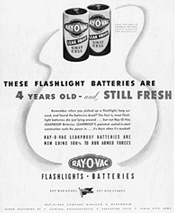
Engineer Herman Anthony of Ray-O-Vac receives a patent for the leakproof battery. His invention is about to go to war.
Wisconsin businessmen founded the company in 1906 as the French Battery Company. By the 1920s, it was making Ray-O-Lite flashlights, and it soon produced Ray-O-Spark batteries for your car’s spark-plug ignition and Ray-O-Vac batteries for your vacuum-tube (see here) portable radio. The company changed its name to Ray-O-Vac in 1934.
Standard old-fashioned zinc-carbon batteries were more portable than wet cells (see here) but had some bad habits. The zinc can would often swell and burst its seams. Then its innards would leak and render your flashlight or radio an inoperative mess.

Anthony solved the problem by using a better grade of manganese in the battery, to reduce the swelling, and then encasing the battery in steel. Bingo. Case closed… literally. Ray-O-Vac showed off its new wonder in 1939, although the patent wasn’t published until 1940. But the leakproofs were not to be had in great number right away.
When the United States entered World War II, batteries were rationed to civilians, and like many other companies, Ray-O-Vac turned its entire production to supplying the military. Troops used the sealed-in-steel batteries to power not just flashlights but everything from walkie-talkies to bazookas. The firm also produced right-angle flashlights that soldiers could hook on their belts and have the light shine forward.
When the war ended, pent-up consumer demand helped the company sell a hundred million of the new batteries in 1946. Ray-O-Vac made a gold-plated flashlight in 1950 to celebrate the production of its billionth leakproof battery.—RA